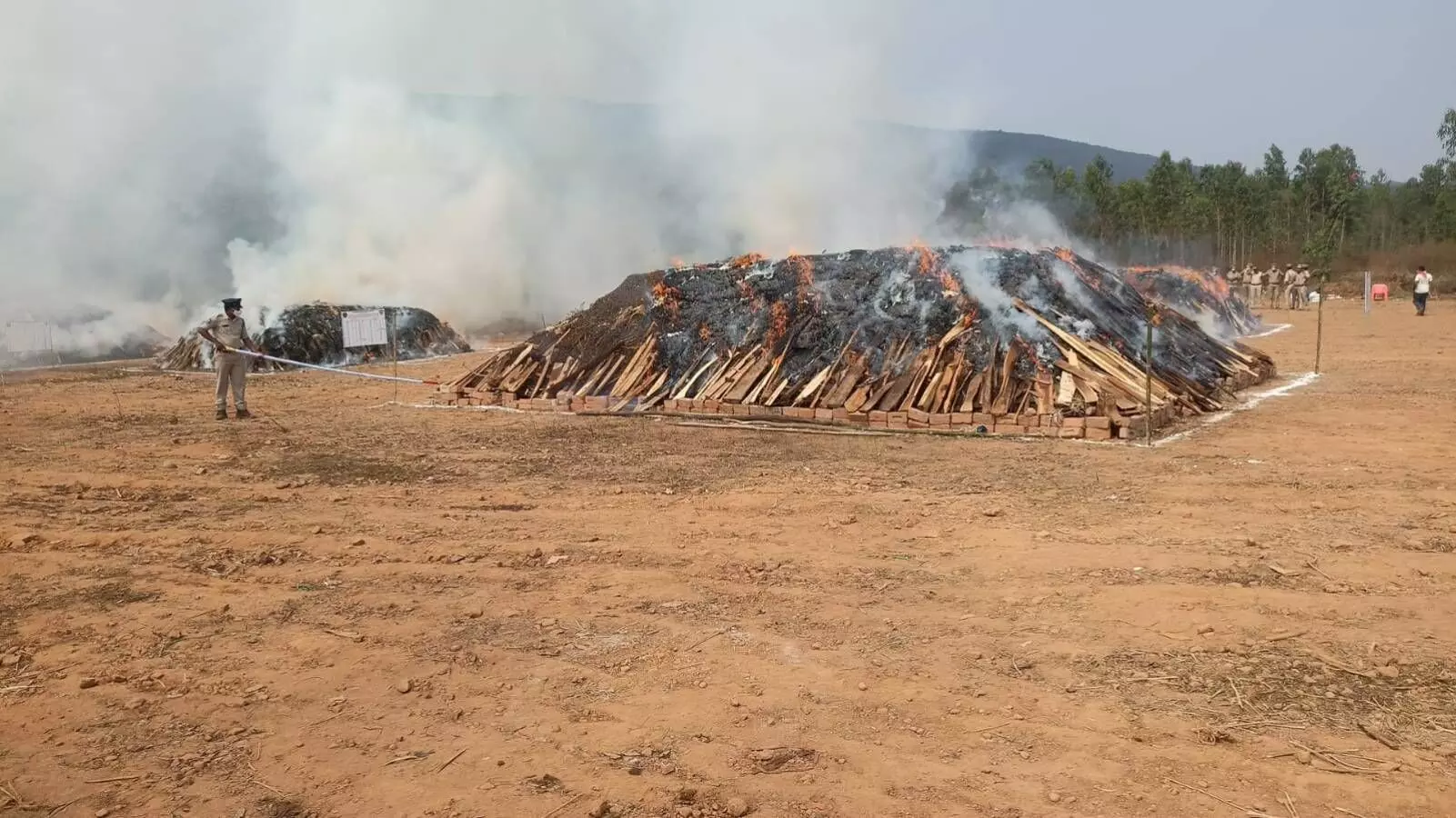From ganja to ashes: How wind direction helped AP police destroy 2L kg of cannabis?
The police have taken all precautionary measures to ensure that the blaze does not affect people living around Koduru village.
By Sri Lakshmi Muttevi
Visakhapatnam: The Andhra Pradesh police on 12 February destroyed two lakh kg of ganja by setting them on fire in the forests of Anakapalli in the Visakhapatnam district. The ganja was divided into 13 heaps, each heap containing 15,000-20,000 kg of cannabis. Each heap was packed with sugar, camphor, firewood, diesel, and dry grass. Sugar was especially included to avoid more smoke. The ganja was set ablaze after taking all necessary precautions and permissions from the AP Pollution Control Board. It is expected to turn to ashes in two days. Until then police and fire personnel have been deployed in the area.
#Watch: @APPOLICE100 set ablaze 2 lakh kgs of Ganja, seized over many months. The estimated cost of the accumulated Ganja is around Rs 500 Cr, cops said.@SriLakshmi_10 pic.twitter.com/1bAGGYUJzr
— NewsMeter (@NewsMeter_In) February 12, 2022
The police have taken all precautionary measures to ensure that the blaze does not affect people living around Koduru village in Anakapalli where the ganja is being destroyed. However, some of them had headache. The AP director-general of police (DGP), Gautam Sawang, set fire to one heap of ganja while the other teams set fire to the other heaps.
"This is not new. Ganja cultivation has been there since independence. To ensure the eradication of ganja cultivation in the state, we have taken up this operation (Operation Parivartana) for a year," said Mr. Sawang. According to the DGP, for many years, 11 mandals in the Vizag agency were dominated by Naxals/Maoists who were propagating illegal ganja cultivation. They were collecting money and getting tribals habituated to ganja cultivation, he said.
The general harvest season is between 1 November and 1 December during which period the police focus on destroying the crop. Simultaneously, the tribals are being given alternative crops to grow and make a living. "Almost 90% of the ganja cultivation has been destroyed. During Operation Parivartana (OP), we focused on remote areas where police had never been before. In the last three months, about 5,000 kg of ganja was seized; 500 major smugglers from Bihar, Delhi, Punjab, Kerala, Telangana, and Tamil Nadu were arrested; and 1,100 vehicles were seized. As part of OP, we also held talks with the police in Odisha, Telangana, Tamil Nadu, and Kerala to stop the transport of ganja," the DGP added.
Speaking about the changes happening in the tribal areas in the last few months, the DGP said the environment in the agency areas has changed a lot. The tribals had been trapped by ganja traders but they are able to own and cultivate their lands now, he added.
How the blaze was setup:
13 heaps of ganja each containing 15,000-20,000 kg were set up. Each heap of ganja was packed with sugar, camphor, firewood, diesel oil, and dry grass. Sugar especially was included to avoid more smoke. Taking all necessary precautions and permissions from AP Pollution Control Board, the total ganja is expected to turn into ashes in two days time. Until the total ganja is turned into ashes, police and fire personnel have been deployed in the area. Each heap of ganja was filled with sugar which is to cut down the effect of THC compound, primarily responsible for 'high factor'.
Rehabilitation
According to the DGP, people living in remote areas who depended on ganja cultivation have now changed their way of living. When one person understands the effects of ganja, they try to motivate every villager to go for alternative crops, he added. The Andhra Pradesh police have ensured that development programmes reach every tribal area. They are providing alternative crops such as turmeric, coffee, ginger, millets, dragon fruit, and pineapple to the tribal people, Mr. Sawang said adding, "The tribals were being used for cultivating ganja and it was only Maoists and traders who were benefitting. The world of tribals in the agency area will change now."
#AndhraPradesh: How @APPOLICE100 used Artificial Intelligence to zero down on farm lands growing Cannabis, resulting in destroying 2 lakh kgs of Ganja worth Rs 500 Cr.
— @Coreena Enet Suares (@CoreenaSuares2) February 12, 2022
Hear @dgpapofficial in conversation with @SriLakshmi_10 @NewsMeter_In. pic.twitter.com/vbEtPJQP4Z
Tribals who changed their ways
T. Marku Raju of Gumurvala panchayat, GK Veedhi, destroyed ganja crop growing on 60-70 acres of his land. In 2000, he started cultivating ganja with the help of traders. "I saw lives getting destroyed due to ganja cultivation where youth were getting involved. I asked many neighbouring villages not to cultivate ganja but no one took me seriously. It was only after a boy from our village who was arrested for ganja transportation died in jail that we realized the situation and approached the police. We now request the government to provide employment to youth in our agency which will help us to change our lives," said Raju.
#AndhraPradesh: A Farmer who realised that Ganja is a banned substance, voluntary came forward and handed over the crop to the enforcement agency. He speaks to @SriLakshmi_10 .@APPOLICE100 set ablaze 2 lakh tons of Ganja at #Vishakapatnam pic.twitter.com/EYBqWkXhxG
— NewsMeter (@NewsMeter_In) February 12, 2022
Drug-free agency
The DGP said 406 teams successfully cracked down on the ganja trade in AP in a year. Stating that the Andhra-Odisha border has been known for ganja cultivation for decades, he said the police used technology to identify various clusters of ganja cultivation in AP. They destroyed 90% of the crops in 7,552 acres worth Rs. 9,251.32 crore (local market value). "While ganja smugglers have their way of transporting the contraband, the police are smarter. In the coming years, the ultimate goal is to make AP a drug-free zone with coordination of the Special Enforcement Bureau and the police," said the DGP.